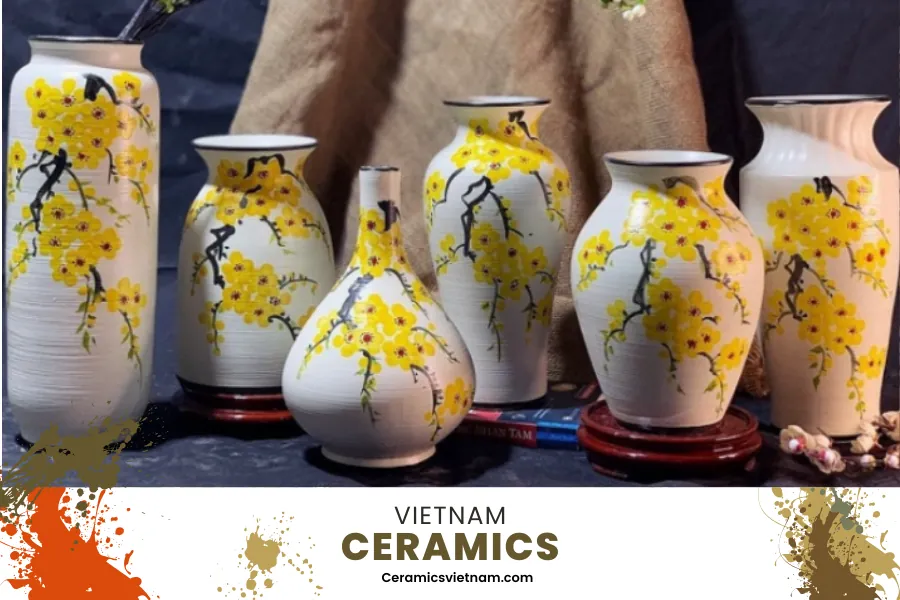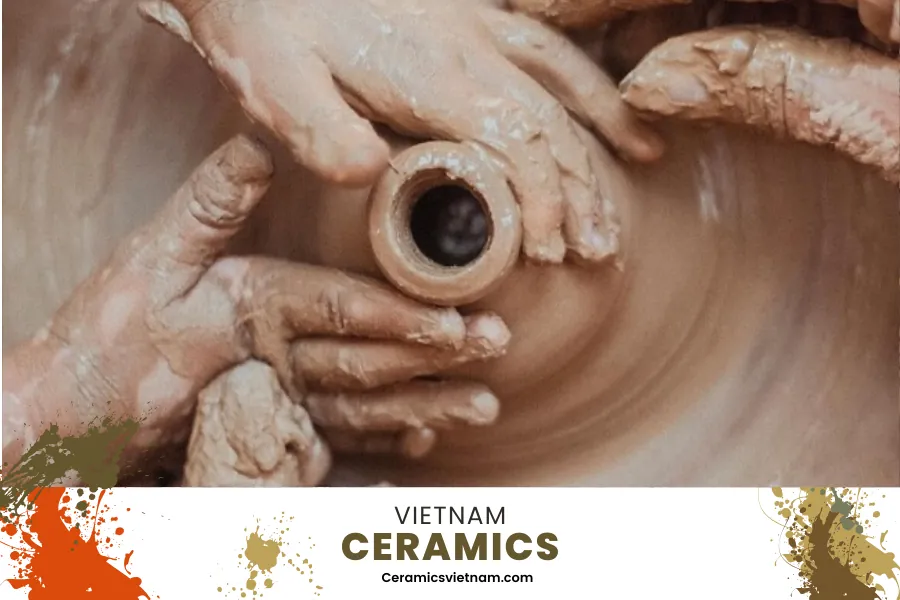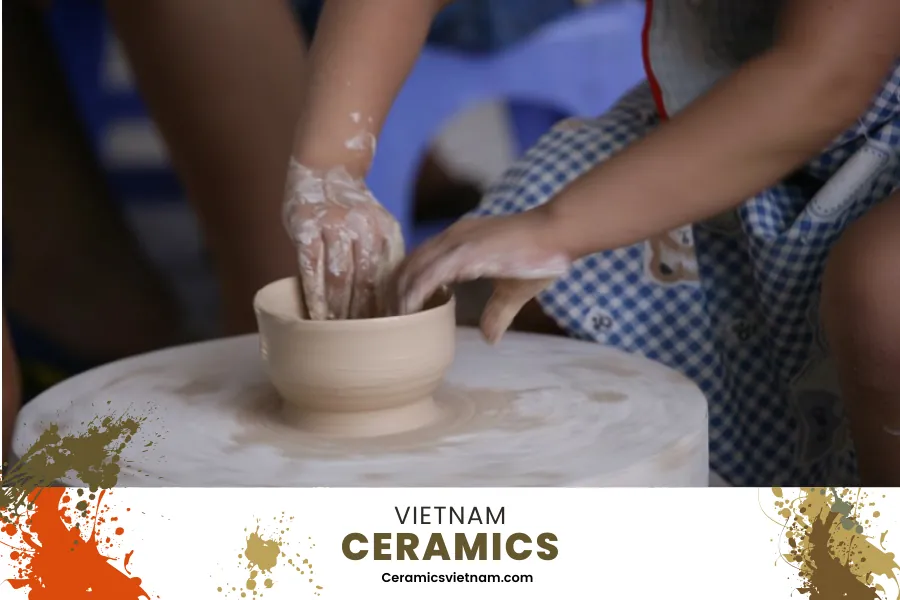Vietnam’s enchanting beautiful pottery villages serve as bastions for the preservation of the age-old traditional pottery craft, offering visitors a plethora of captivating and engaging tourist experiences.
Beautiful pottery villages in Vietnam have a long history of development
Bat Trang Pottery Village

Visit beautiful pottery villages in Vietnam
Nestled in the outskirts of Hanoi, the Bat Trang pottery village stands as one of Vietnam’s cherished destinations, capturing the hearts of both local and international tourists. Situated in Bat Trang commune, Gia Lam district, this traditional craft village boasts a rich history dating back to the Ly Dynasty, with a legacy of over 500 years.
Approximately 10 kilometers from the capital’s center, Bat Trang welcomes visitors to a sprawling craft village, home to more than 600 ceramic workshops, both large and small. Generations of families here have faithfully carried on the pottery-making legacy handed down by their forefathers, producing a diverse array of high-quality ceramic goods crafted from white clay.
Originally, Bat Trang was a lofty clay mound situated along the Red River’s left bank. Over time, the art of pottery emerged, transforming the area into a historical craft village dedicated to preserving the essence of ceramic art. Today, Bat Trang’s handmade ceramic products are lauded for their exceptional quality, innovative designs, and practicality.
Travelers exploring Hanoi and venturing to Bat Trang have the opportunity to marvel at household ceramics, decorative pieces, artistic constructions, and ceremonial objects. Beyond mere observation, visitors can immerse themselves in the craft by creating their own ceramic masterpieces.
Having evolved over centuries, Bat Trang pottery village has become a prominent supplier of ceramic products, catering to both domestic and international markets. The village now attracts tourists with its picturesque shops, captivating public photography spots, and the chance to engage in a hands-on pottery experience. This enduring destination not only captivates with its cultural richness but also entices visitors with its photogenic charm, making it a must-visit location in the realm of Vietnamese pottery.
Chu Dau Pottery Village

Visit beautiful pottery villages in Vietnam
Chu Dau Pottery Village, nestled in Thai Tan commune, Nam Sach district, Hai Duong province, stands as a century-old bastion of traditional ceramics in Vietnam. Its roots trace back to the 14th century, flourishing notably during the 15th and 16th centuries, as recorded by history.
Despite facing historical shifts and the passage of time that led to its decline, the village experienced a revival in 2001. Extensive research was undertaken to restore production techniques, enamels, and designs, gradually propelling Chu Dau Pottery Village back to its former glory.
Distinguished by the use of white clay sourced from Truc Thon, Hai Duong, Chu Dau pottery sets itself apart in materiality. The white clay undergoes a meticulous process—mining, mixing with water, filtration through a system of troughs and tanks to create a pure liquid, incorporation of additives, and finally, the formation of ceramic products. The skilled artisans of the village, with their adept hands, produce exquisite and intricate works.
Beyond its distinctive ceramic material, Chu Dau Pottery Village boasts unique textures and patterns. The pattern lines on these ceramics carry deep meanings rooted in Vietnamese philosophy, beliefs, and the essence of the soul. Images depicting Lac Viet birds, lotus flowers, chrysanthemums, and more are meticulously painted under durable and delicate enamel.
Having weathered numerous ups and downs, Chu Dau Pottery Village showcases resilience and adaptability. Today, it offers three traditional pottery lines catering to export activities, household products, and antique ceramics. Visitors exploring this pottery haven are treated to a visual feast of Pi Ba vases, five-element cup pots, dragon wine pots, and other masterfully crafted pieces, showcasing the enduring artistry and heritage of Chu Dau Pottery Village.
Thanh Ha Pottery Village

Visit beautiful pottery villages in Vietnam
When journeying to Hoi An, don’t forget to explore the enchanting Thanh Ha Pottery Village, situated in Thanh Ha ward, Hoi An city. Nestled along the picturesque Thu Bon river, this pottery village boasts a rich history spanning 500 years, making it a cherished destination in Quang Nam.
Renowned for its exquisite and robust terracotta products, Thanh Ha Pottery Village earned a place among the “national products” during the Nguyen Dynasty. The zenith of its prosperity occurred in the 17th and 18th centuries, when the locals exclusively adorned their homes with the distinct Thanh Ha pottery.
What sets Thanh Ha Pottery Village apart is its use of ceramic raw materials, resulting in products adorned with a striking orange-red hue. As a result, this beautiful pottery village predominantly crafts paintings, statues, and decorative lights, catering to both domestic and international demands.
While the village experienced a period of obscurity in its long history, the recognition of Hoi An as a UNESCO World Cultural Heritage site breathed new life into Thanh Ha Pottery Village. Gradually, it has transformed into a sought-after tourist attraction in the captivating landscape of Hoi An.
Visitors to this pottery haven can revel in its beauty by purchasing a 35,000 VND ticket, granting access to the village’s scenic charms, a visit to Xuan My communal house, and the opportunity to witness artisans crafting unique ceramic pieces. The highlight of the experience lies in the chance to create personalized ceramic wares, complete with one’s individual stamp—a hands-on immersion into the artistry of Thanh Ha Pottery Village.
Bau Truc Pottery Village

Visit beautiful pottery villages in Vietnam
Bau Truc, a renowned traditional pottery village specializing in ceramic production, is situated in Phuoc Dan town, Ninh Phuoc district, Ninh Thuan province. Distinguished as the oldest pottery village in Southeast Asia, Bau Truc is celebrated for its distinctive firing technique, resulting in a range of products that bear the hallmark of Cham culture, setting it apart from pottery in any other locality.
Presently, this exquisite pottery village in Vietnam is home to approximately 400 pottery-producing households, engaging in vibrant and productive activities, always open to welcoming visitors. Exploring Bau Truc, visitors find themselves immersed in a captivating ambiance with display houses showcasing an array of pots, pans, bowls, kettles, and more.
Bau Truc pottery is crafted entirely by hand, employing an outdoor firing technique. The process involves burning with wood and covering with straw at temperatures ranging from 700 to 900 degrees Celsius, yielding products known for their exceptional durability and outstanding quality—a distinctive characteristic of Bau Truc ceramics.
Venturing to Ninh Thuan provides a unique opportunity to witness skilled artisans shaping pottery with meticulous precision. Visitors can also actively engage in the pottery-making experience, from drawing patterns to firing pottery, gaining a deeper understanding of the various stages of this ancient craft.
Beyond its cultural and historical significance, Bau Truc offers visitors the chance to acquire ceramic treasures as gifts or partake in the hands-on experience of creating their own pottery. Each pottery village in Vietnam, with its distinct history and development, showcases a unique charm. While their shaping and production techniques may differ, traditional Vietnamese ceramics are universally cherished for their high quality, exquisite designs, and enduring durability.
The experience of making pottery oneself

Visit beautiful pottery villages in Vietnam
Engaging in pottery making in traditional pottery villages under the guidance of skilled artisans can indeed be a unique and enriching endeavor. Here are some reasons why:
- Cultural Immersion:
- Traditional pottery villages often have a rich cultural history associated with their craft. Participating in pottery making allows you to immerse yourself in the local culture and understand the significance of pottery in that community.
- Hands-On Learning:
- Learning directly from skilled artisans provides a hands-on experience that goes beyond theoretical knowledge. The tactile nature of working with clay helps you develop a deeper understanding of the craft.
- Preservation of Traditional Techniques:
- Many traditional pottery techniques have been passed down through generations. By learning from skilled artisans, you contribute to the preservation of these techniques, helping to ensure that they are not lost over time.
- Personal Creativity:
- Working with clay allows for personal expression and creativity. Under the guidance of skilled artisans, you can learn not only the traditional techniques but also explore your own artistic ideas and style.
- Sense of Accomplishment:
- Creating a piece of pottery from start to finish can be a rewarding experience. From shaping the clay to firing and glazing, each step adds to the sense of accomplishment when you see the final product.
- Connection to Nature:
- Working with natural materials like clay connects you to the earth. Traditional pottery often involves using locally sourced materials, creating a strong link between the craft and the natural environment.
- Community Interaction:
- Pottery making in traditional villages is often a communal activity. You get to interact with local artisans, share stories, and build connections within the community, fostering a sense of belonging.
- Relaxation:
- The process of pottery making requires focus and concentration. It can be a meditative and relaxing activity, allowing you to escape from the fast-paced modern world and be present in the moment.
- Appreciation for Craftsmanship:
- Learning the intricacies of pottery making makes you appreciate the skill and craftsmanship involved. You gain a deeper understanding of the time and effort required to create handmade pottery.
- Souvenir and Memory:
- The pottery you create becomes a tangible reminder of your experience. It serves as a unique souvenir and a lasting memory of your time spent in the traditional pottery village.
Participating in pottery making in traditional villages not only offers a chance to learn a valuable craft but also provides a holistic and culturally rich experience that can be immensely fulfilling.














Leave a reply